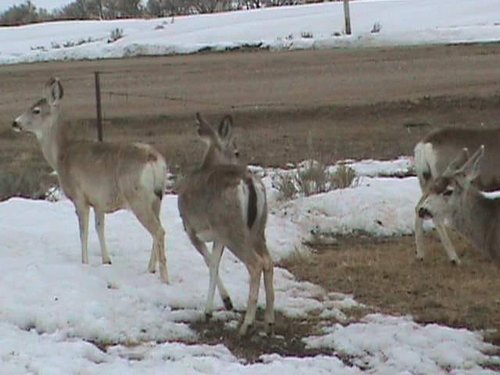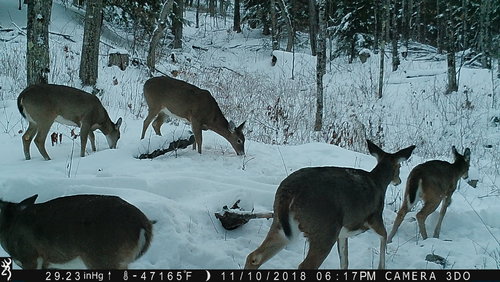Navigation
Install the app
How to install the app on iOS
Follow along with the video below to see how to install our site as a web app on your home screen.
Note: This feature may not be available in some browsers.
More options
You are using an out of date browser. It may not display this or other websites correctly.
You should upgrade or use an alternative browser.
You should upgrade or use an alternative browser.
Odd Deer Herd
- Thread starter WyoDoug
- Start date
WNC2500
Well-known member
Muley in with WT?
WyoDoug
Well-known member
Other way around. The one in the middle is a whitetail. The rest are mulies. Muley tails are white with black tip kind of rope like. Whitetails have a black layer of fur when they are not on alert and then the white "flag" when they are alerted. Whitetails also have wider tails than mulies.Muley in with WT?
WyoDoug
Well-known member
Could be. I believe this is in the area around Wheatland and with so many of both species they mingle now and then and I doubt if you find a true purebred of either species in that area.Awful dark on the backside of that tail for most whitetails. Also the head/ears don't really look 100% whitetail, could be a hybrid.
MTLabrador
Well-known member
Mule deer/whitetail hybrids are extremely rare, even in areas where mule deer and whitetails frequently coexist.Could be. I believe this is in the area around Wheatland and with so many of both species they mingle now and then and I doubt if you find a true purebred of either species in that area.
D
Deleted member 20812
Guest
People see an animal with slightly different markings or antler configurations and automatically come to the conclusion it’s a hybrid. Shit happens. Genetic expression can be a little random.Mule deer/whitetail hybrids are extremely rare, even in areas where mule deer and whitetails frequently coexist.
Wildabeest
Well-known member
It’s cross-legged too. Freak of nature! 
WyoDoug
Well-known member
But... in saying what I did about hybrid I am not a biologist and not 100% sure hybrids can breed. I know with mules which are a cross between a horse and a donkey that the jennies are generally infertile.
Last edited:
I will admit hybrids are rare, but they do happen. I also will agree that there are diffierences in pelage geopgraphically and from among individuals. There are only a few scientific methods to determine a true hybrid. This isn't the greatest pic either, but comparing the ears to the mule deer on the left with the the middle deer you have to admit that they are similar in size and coloration. The middle deer also has a darker "scalp" above the eye than most of the whitetails that I am familiar with. It would help to have some better photos and some photos from other angles, but short of putting it on the ground and doing some measurements and or genetic testing we will never know. I also agree that antler configuration is a very poor way to determine hybridization, especially when they aren't present.
kwyeewyk
Well-known member
Mule deer/whitetail hybrids are extremely rare, even in areas where mule deer and whitetails frequently coexist.
While learning about hybrids in my local area I found out that your statement is mostly true for first generation hybrids, but the hybrid females that do occur are able to breed and so the hybrid genetics actually persist in the population at varying levels depending on the frequency of new hybridization events. The hybrid traits can pop up here and there in the population, or just express as slight variations from what we think of as normal. Since it's usually whitetail bucks breeding mule deer does it tends to be the mule deer population that holds the most whitetail genetics. But it could also just be variation of genetics, the metatarsal glands or an actual DNA sample are the only way to really know. Hard to tell from the photo. Been meaning to update the thread I started about hybrids awhile back, there's a pretty good article that one of our local biologist sent me about it.
TheNorthStar
Well-known member
Awful dark on the backside of that tail for most whitetails. Also the head/ears don't really look 100% whitetail, could be a hybrid.
To be honest, doesn't look like any whitetail I've encountered.
huronmtns
Well-known member
Watching them run is a big indicator. I have never seen a whitetail spring off of all four legs at one time during movement.
Like all those 3 pt muleys gotta be hybrids!People see an animal with slightly different markings or antler configurations and automatically come to the conclusion it’s a hybrid. Shit happens. Genetic expression can be a little random.
QuazyQuinton
Well-known member
Given your location, I assume these are Wyoming deer. I think a whitetail-mule deer hybrid is a possibility, but I would like to see more whitetail traits before I went down that road. If you want to talk about mixed genes, I would actually suggest that the odd genes look more like blacktail than whitetail. Geographically, that doesn't seem like a viable possibility for a straight up hybrid, but I bet there's some genetic material popping up every once in a while.
QQ
huronmtns
Well-known member
rtraverdavis
Well-known member
I’m having a hard time seeing anything whitetailish in any of those deer in that picture.
QuazyQuinton
Well-known member
I’m having a hard time seeing anything whitetailish in any of those deer in that picture.
The deer in the foreground with his rear toward the camera has a solid black topside to his tail. You know, like what we would call a benchleg.
azelkhntr
Well-known member
- Joined
- Mar 21, 2020
- Messages
- 456
Mule deer/whitetail hybrids are extremely rare, even in areas where mule deer and whitetails frequently coexist.
Mule deer white tail crossbreds are known as blacktail deer and hardly rare. A seperate species now. Genetically proven fact. In the top photo I see 2 mulies and 2 blacktails.
QuazyQuinton
Well-known member
Blacktails are a subspecies of mule deer, not the result of hybridization.
The deer in that picture are all mule deer.
QQ
The deer in that picture are all mule deer.
Similar threads
- Replies
- 67
- Views
- 5K
- Replies
- 16
- Views
- 1K






